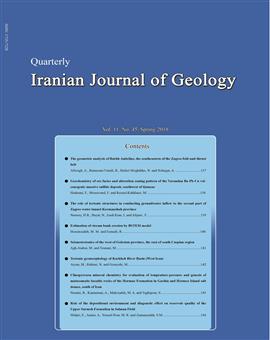-
-
List of Articles
-
Open Access Article
1 - The geometric analysis of Burkh Anticline, the southeastern of the Zagros fold-and-thrust belt
-
Open Access Article
2 - The geometric analysis of Burkh Anticline, the southeastern of the Zagros fold-and-thrust belt
Ramzan Ramzani Umali Naser Hafezi Moghaddas Ahmad Nohegar Abdolvahab Afroogh -
Open Access Article
3 - Geochemistry of ore facies and alteration zoning pattern of the Varandan Ba-Pb-Cu volconogenic massive sulfide deposit, southwest of Qamsar
Fayegh Hashemi Fardin Mousivand Mahdi Rezaei-Kahkhaei -
Open Access Article
4 - The role of tectonic structures in conducting groundwater inflow to the second part of Zagros water tunnel – Kermanshah province
HamidReza Nasseri Narges Bayat Lili Izadi Kian Farshad Alijani -
Open Access Article
5 - Estimation of stream bank erosion by BSTEM model
محمد مهدي حسين زاده Reza Esmaili -
Open Access Article
6 - Seismotectonics of the west of Golestan province, the east of south Caspian region
Maryam Agh-Atabai Marjan Tourani -
Open Access Article
7 - Tectonic geomorphology of Karkheh River Basin (West Iran)
Negin Rahimi Mehran Aryan Manouchehr Ghoreshi -
Open Access Article
8 - Clinopyroxen mineral chemistry for evaluation of temprature - pressure and genesis of matasomatic basaltic rocks of the Hormuz Formation in Gachin and Hormoz Island salt domes, south of Iran
Roghayeh Nemati Ali Kananian MohamadAli Makizadeh Sedigheh Taghipour -
Open Access Article
9 - Role of the depositional environment and diagenetic effect on reservoir quality of the Upper Surmeh Formation in Salman Field
Ebrahim Sefidari Abdolhossein Amini Mohamad Reza Yousef-Pour Seyed Mohad Zamanzadeh
-
The rights to this website are owned by the Raimag Press Management System.
Copyright © 2017-2025







